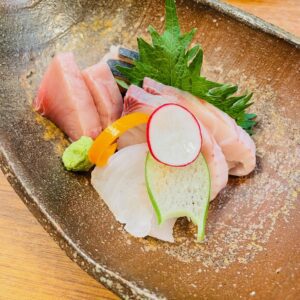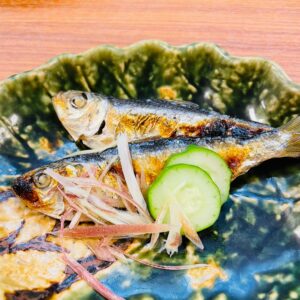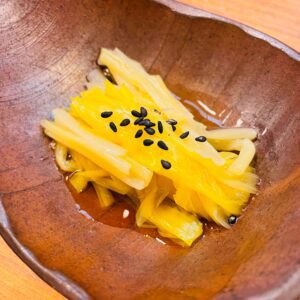March itinerary in Japan Day 4 (Hiroshima, Okayama Meal ed.)
(Friday, March 25)
Table of contents
1. Onomichi Ramen Iccho
I returned to Fukuyama Station from Tomonoura, Myo-in and Kusado Inari Shrine, and had lunch at “Onomichi Ramen Iccho”. As I posted on the BLOG on April 19, there are two types of Onomichi ramen, and Hiroshi Iwaoka, the founder of the Shin-Yokohama Ramen Museum says, “Onomichi ramen should be called Onomichi / Fukuyama ramen.” Therefore, Onomichi ramen eaten in Fukuyama City can be called local ramen.
Many customers lined up at “Onomichi Ramen Iccho” even after 13:00. There is no doubt that it is a popular ramen shop in Fukuyama City. With a high score of 3.62 in Tabelog, it is listed as the top ramen shop in Fukuyama City.
I ordered “ramen” (Yen 650). The ramen of “Onomichi Ramen Iccho” was a typical “Onomichi ramen” with a lot of fatty upper part of roast pork floating in black soy sauce soup.

The taste of ramen was one of the best ramen I ate recently. The noodles were a little soft at “Kukai” in Onomichi City the day before, but the ramen at “Onomichi Ramen Iccho” was my favorite firm noodles. Also, because the soup contains a lot of fatty upper part of roast pork, it was a hot soup until I finished eating it.
This ramen was best for me because of the taste, the hardness of the noodles, and the hot soup. I was very satisfied and left the ramen shop. When I came to Fukuyama City, I definitely decided to visit again.
2. Local cuisine Hamayoshi
After sightseeing in Kurashiki, I had dinner at “Local cuisine Hamayoshi“. I ordered “Assorted sashimi”, “Vinegared Mamakari (Japanese sardinella)”, “Berata (juvenile conger)”, “Ohitashi of yellow Chinese chives”, “Beka squid”, “Tako-miso (Liver of Octopus)” and “Tako-mochi (octopus egg) ”. I was able to eat various kinds of local dishes and delicacies.
“PRIDE FISH” in Okayama Prefecture, selected by Japan Fisheries Co-operative, includes “Asabi no Sawara (Spanish mackerel)” (season: April-June). This time, the “Assorted sashimi” of “Hamayoshi” contained Spanish mackerel sashimi, and I was able to enjoy its deliciousness.

“Hamayoshi” is a local restaurant that mainly serves fish landed at Shimotsui Fishing Port in Kurashiki City. The Shimotsui fishing port was a very prosperous port during the Edo period, with Kitamae-bune (cargo ships that sailed the Japan Sea during the Edo period) and Gozabune (boat reserved for nobles) of Sankin-kotai (daimyo’s alternating Edo residence). Shimotsui Fishing Port is still one of the leading fishing ports in the Seto Inland Sea. It is a fishing port at the foot of the Seto Long‐Bridge.
The “Vinegared Mamakari (Japanese sardinella)” made by pickling the baked Mamakari of “Hamayoshi” was excellent. Usually, “Vinegared Mamakari” is pickled without baking Mamakari, but although the baked Mamakari is pickled, it has the aroma unique to grilled fish and has an exquisite taste.

The Ministry of Agriculture, Forestry and Fisheries has selected “Vinegared Mamakari” as “Our Regional Cuisines” in Okayama prefecture. “Mamakari” is the name of Okayama prefecture, and it is a small fish called “Sappa” in the Kanto region. I have lived in Tokyo for 25 years and have never heard of a fish called “Sappa”. On the other hand, I am familiar with the fish name “Mamakari” probably because I am from Hyogo prefecture next to Okayama prefecture. I feel that the name “Mamakari” is more famous nationwide, but is it because of me? In addition, it seems that only Kagawa and Hiroshima prefectures around Okayama prefecture use “Mamakari (Japanese sardinella)” as food.
I think it’s famous, but the etymology of “Mamakari” is “I go to borrow (kari) rice (manma) next to me because it’s so delicious.” By the way, the etymology of “sappa” is said to be because it has a refreshing taste (sappari) compared to the same clupeidae, gizzard shad. In any case, the strange etymology is the fish name. In addition, it seems that “Sappa” is thrown away as a mixed small fish even if it is caught in the Kanto region.
In addition, Japan Fisheries Co-operative has selected “Mamakari (Japanese sardinella)” as the autumn “PRIDE FISH” in Okayama Prefecture. The season is from September to November.
“Berata (juvenile conger)” was also delicious with a smooth texture. “Berata” is a fry of conger eel and is the name in Okayama prefecture. It is called “Noresore” nationwide. In addition, “Noresore” is the name spread all over the country in Kochi prefecture. In Hyogo prefecture (Awaji Island and Akashi city), it is called “Hanatale”, and in Ibaraki prefecture, it is called “Peropero”. There are various names. “Berata” is often caught from January to March, so the end of March I ate was the last season.

“Ohitashi of yellow Chinese chives” is also selected as “Our Regional Cuisines” in Okayama prefecture. Yellow Chinese chives is a special product of Okayama prefecture and boasts 70% of the national production. Yellow Chinese chives is the same type of Chinese chives as ordinary Chinese chives, but the cultivation method is different. By cultivating it by blocking the light, it suppresses the generation of chlorophyll and makes it yellow, and after harvesting, it becomes bright yellow by exposing it to sunlight. Yellow Chinese chives is not addictive enough to be eaten raw and has an elegant scent. “Hamayoshi”‘s “Ohitashi of yellow Chinese chives” was very delicious.

“Beka squid” is the “chii-chii squid” that I ate in Fukuyama City the day before. “Beka squid” I had the day before had a little smell (unique bitterness), but “Beka squid” of “Hamayoshi” had no smell at all. It was a very delicious “Beka squid”. The season for “Beka squid” in Okayama Prefecture is from April to mid-June.

The food that impressed me most at “Hamayoshi” was “Tako-miso (Liver of Octopus)”. I ate octopus liver for the first time in my life. Tako-miso is made by boiled down liver and seasoned with seasonings, frozen, and then sliced into thin slices at “Hamayoshi”. It was an excellent delicacy that goes well with sake. I can’t stop traveling because I can meet such exquisite dishes. The octopus landed at the Shimotsui fishing port mentioned above is famous nationwide as “Shimotsui octopus”.

The last “Tako-mochi (octopus egg)” I ordered was not as impressive as “Tako-miso”, but it was a delicious delicacy. “Tako-mochi” is a food made by boiling octopus eggs with ponzu sauce. The bubble wrap texture of the octopus egg was best.

This trip to Hiroshima and Okayama for 3 nights and 4 days was also very satisfying with a series of delicious dishes. I could only travel half a day in Okayama prefecture, so next time I would like to travel more slowly in Okayama prefecture.
Note: The departure / arrival times, fares, admission fees of transportation, meal fees, etc. listed in the text are as of the time of writing the BLOG. Please check for yourself when you go on a trip as it may change in the future.
